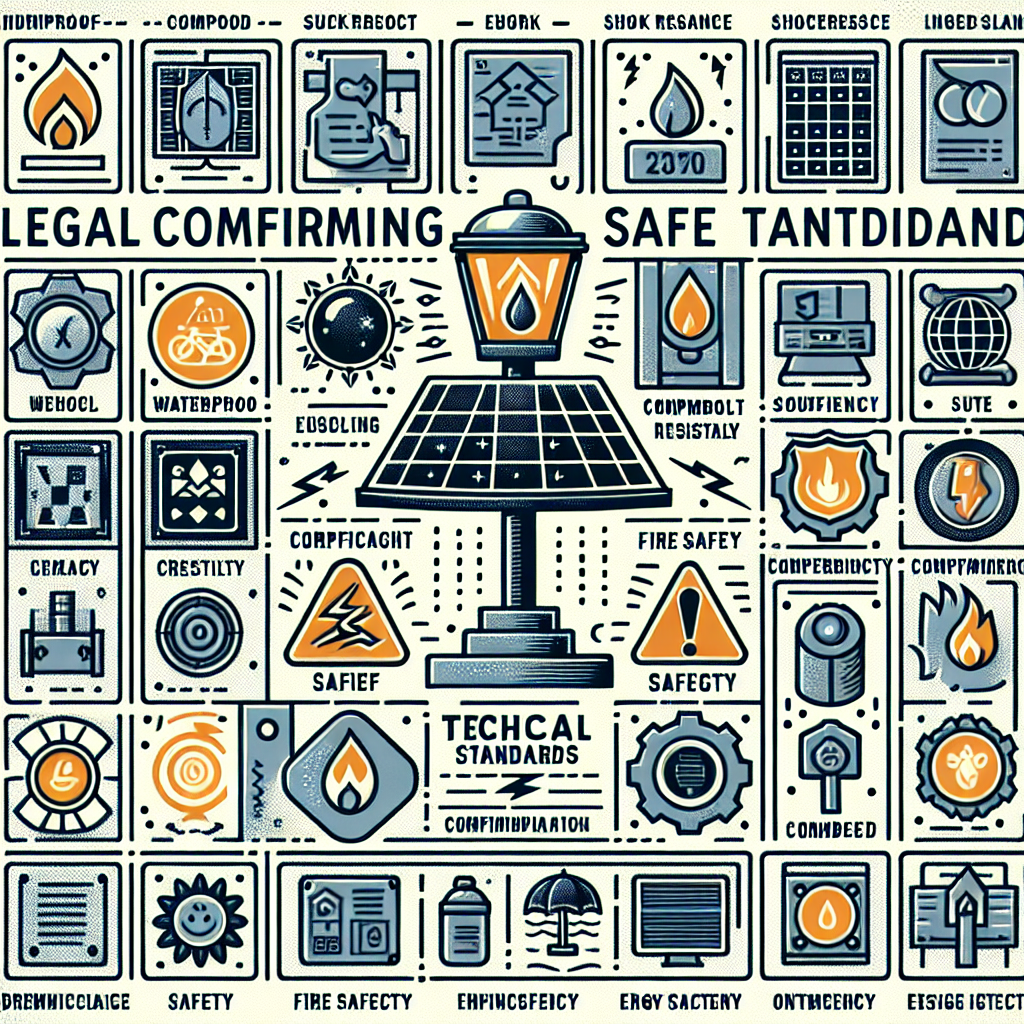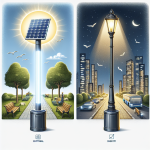Regulations and Standards for Solar Bollards
-
Table of Contents
Regulations and standards for solar bollards are essential guidelines and criteria established to ensure the safety, efficiency, and reliability of these solar-powered lighting devices. These regulations encompass various aspects, including design, installation, performance, and maintenance, to ensure that solar bollards meet specific quality and safety benchmarks. Standards are often developed by international, national, and industry-specific organizations to provide a consistent framework for manufacturers, installers, and users. Compliance with these regulations and standards helps in promoting the adoption of solar bollards, enhancing their performance, and ensuring their integration into public and private spaces is both effective and sustainable.
Understanding Compliance: Key Regulations for Solar Bollards
Solar bollards, increasingly popular for their energy efficiency and environmental benefits, must adhere to a range of regulations and standards to ensure safety, performance, and reliability. Understanding these compliance requirements is crucial for manufacturers, installers, and users alike. This article delves into the key regulations governing solar bollards, providing a comprehensive overview of the standards that must be met.
What Are the General Electrical Safety Standards for Solar Bollards?
To begin with, solar bollards must comply with general electrical safety standards. These standards are designed to prevent electrical hazards, such as short circuits and electrical shocks. The International Electrotechnical Commission (IEC) sets forth many of these standards, including IEC 60598, which pertains to the safety of luminaires. Compliance with this standard ensures that solar bollards are safe to use in various environments, reducing the risk of electrical accidents.
What Performance Standards Must Solar Bollards Meet?
In addition to electrical safety, solar bollards must meet specific performance standards. These standards assess the efficiency and durability of the solar panels, batteries, and LED lights used in the bollards. The IEC 61215 standard, for instance, evaluates the performance of crystalline silicon photovoltaic (PV) modules, which are commonly used in solar bollards. This standard ensures that the solar panels can withstand environmental stresses, such as temperature fluctuations and humidity, thereby guaranteeing long-term performance.
How Are the Batteries in Solar Bollards Regulated?
Moreover, the batteries used in solar bollards are subject to rigorous testing to ensure their reliability and safety. The IEC 62133 standard outlines the requirements for the safe operation of rechargeable batteries, including lithium-ion batteries, which are frequently used in solar bollards. This standard addresses potential hazards such as overcharging, overheating, and short-circuiting, ensuring that the batteries can operate safely over their expected lifespan.
What Environmental Regulations Apply to Solar Bollards?
Transitioning to environmental considerations, solar bollards must also comply with regulations aimed at minimizing their environmental impact. The Restriction of Hazardous Substances (RoHS) directive, for example, restricts the use of certain hazardous materials in electrical and electronic equipment. Compliance with RoHS ensures that solar bollards do not contain harmful substances such as lead, mercury, and cadmium, thereby reducing their environmental footprint.
How Do Solar Bollards Address Light Pollution and Energy Efficiency?
Furthermore, solar bollards must adhere to standards related to light pollution and energy efficiency. The International Dark-Sky Association (IDA) provides guidelines to minimize light pollution, which can have adverse effects on wildlife and human health. Solar bollards designed to meet IDA standards emit minimal light pollution, ensuring that they provide adequate illumination without disrupting the natural environment. Additionally, energy efficiency standards, such as those set by the U.S. Department of Energy (DOE), ensure that solar bollards use energy effectively, maximizing their sustainability benefits.
What Are the Installation and Maintenance Standards for Solar Bollards?
In terms of installation and maintenance, solar bollards must comply with local building codes and standards. These codes vary by region and may include requirements for the placement, height, and spacing of bollards to ensure they provide adequate illumination and do not pose a hazard to pedestrians or vehicles. Compliance with these codes is essential for the safe and effective deployment of solar bollards in public and private spaces.
Navigating Industry Standards: Ensuring Quality in Solar Bollard Manufacturing

Navigating the complex landscape of industry standards and regulations is crucial for ensuring the quality and reliability of solar bollards. These outdoor lighting fixtures, which harness solar energy to illuminate pathways, parks, and other public spaces, must adhere to stringent guidelines to guarantee their performance, safety, and durability. Understanding these standards is essential for manufacturers, installers, and consumers alike, as it ensures that the products meet the necessary criteria for efficiency and longevity.
What Are the Key IEC Standards for Solar Bollards?
One of the primary standards governing solar bollards is the International Electrotechnical Commission (IEC) standards, particularly IEC 61215 and IEC 61730. These standards focus on the design qualification and safety of photovoltaic (PV) modules, which are integral components of solar bollards. IEC 61215 outlines the testing procedures to assess the performance of PV modules under various environmental conditions, ensuring that they can withstand factors such as temperature fluctuations, humidity, and mechanical stress. Meanwhile, IEC 61730 addresses the safety aspects, including electrical insulation and fire resistance, to prevent hazards during the operation of solar bollards.
What Role Do ASTM Standards Play in the U.S.?
In addition to IEC standards, the American Society for Testing and Materials (ASTM) provides guidelines that are particularly relevant in the United States. ASTM E2848, for instance, specifies the standard test methods for determining the performance of solar lighting systems. This includes evaluating the luminous efficacy, which measures the amount of light produced per unit of power consumed, and the overall energy efficiency of the system. Adhering to these standards ensures that solar bollards provide adequate illumination while minimizing energy consumption, thereby contributing to sustainability goals.
How Does ISO 9001 Impact Solar Bollard Manufacturing?
Furthermore, the International Organization for Standardization (ISO) has established ISO 9001, a quality management system standard that applies to the manufacturing processes of solar bollards. ISO 9001 emphasizes the importance of consistent product quality and continuous improvement, requiring manufacturers to implement rigorous quality control measures and regular audits. Compliance with ISO 9001 not only enhances the reliability of solar bollards but also boosts consumer confidence in the products.
What Environmental Regulations Must Solar Bollards Comply With?
Another critical aspect of solar bollard manufacturing is compliance with environmental regulations. The Restriction of Hazardous Substances (RoHS) directive, for example, restricts the use of certain hazardous materials in electrical and electronic equipment. By adhering to RoHS, manufacturers ensure that their solar bollards are free from harmful substances such as lead, mercury, and cadmium, thereby reducing environmental impact and promoting public health.
Why Is the IP Rating System Important for Solar Bollards?
Moreover, the Ingress Protection (IP) rating system, defined by the IEC standard 60529, is essential for assessing the durability of solar bollards against dust and water ingress. An IP rating typically consists of two digits, with the first indicating the level of protection against solid particles and the second against liquids. For instance, an IP65 rating signifies that the solar bollard is dust-tight and can withstand water jets from any direction. Ensuring a high IP rating is vital for outdoor applications, as it guarantees the resilience of solar bollards in various weather conditions.
What Is the Overall Importance of Adhering to Standards for Solar Bollards?
In closing, navigating industry standards and regulations is fundamental to ensuring the quality and reliability of solar bollards. By adhering to IEC, ASTM, ISO, RoHS, and IP rating guidelines, manufacturers can produce solar bollards that meet stringent performance, safety, and environmental criteria. This not only enhances the functionality and durability of the products but also fosters consumer trust and contributes to sustainable development. As the demand for renewable energy solutions continues to grow, maintaining high standards in solar bollard manufacturing will remain a key priority for the industry.
Safety and Efficiency: Regulatory Requirements for Solar Bollard Installation
Solar bollards, increasingly popular for their energy efficiency and environmental benefits, are subject to a range of regulations and standards designed to ensure their safety and efficiency. These regulatory requirements are essential for guiding manufacturers, installers, and users in the proper deployment and maintenance of solar bollard systems. Understanding these regulations is crucial for anyone involved in the installation and operation of solar bollards.
To begin with, safety is a paramount concern in the installation of solar bollards. Regulatory bodies have established stringent guidelines to mitigate potential hazards associated with these devices. For instance, the International Electrotechnical Commission (IEC) provides standards that address the electrical safety of solar-powered devices. Compliance with IEC standards ensures that solar bollards are designed to prevent electrical shocks, short circuits, and other electrical malfunctions. Additionally, the Underwriters Laboratories (UL) certification is often required in many regions, signifying that the solar bollards have undergone rigorous testing for safety and performance.
Moreover, the structural integrity of solar bollards is another critical aspect governed by regulations. These devices must withstand various environmental conditions, including wind, rain, and temperature fluctuations. Standards such as those from the American Society for Testing and Materials (ASTM) specify the materials and construction methods that ensure durability and resilience. Adherence to these standards not only enhances the longevity of solar bollards but also minimizes maintenance costs and potential safety risks.
Transitioning to the efficiency aspect, regulatory requirements also emphasize the performance of solar bollards. The efficiency of the photovoltaic cells used in these devices is a key factor. Standards set by organizations like the International Organization for Standardization (ISO) and the Institute of Electrical and Electronics Engineers (IEEE) outline the minimum efficiency levels for solar panels. These standards ensure that solar bollards generate sufficient energy to operate reliably, even in less-than-ideal weather conditions. Furthermore, energy storage systems, such as batteries, must meet specific criteria for capacity and longevity, ensuring that the bollards remain functional during periods of low sunlight.
In addition to safety and efficiency, environmental considerations play a significant role in the regulatory landscape for solar bollards. Many regions have adopted regulations that mandate the use of environmentally friendly materials and manufacturing processes. For example, the Restriction of Hazardous Substances (RoHS) directive in the European Union restricts the use of certain hazardous materials in electronic devices, including solar bollards. Compliance with such regulations not only protects the environment but also promotes sustainable practices within the industry.
Furthermore, the installation process itself is subject to regulatory oversight. Local building codes and zoning laws often dictate the placement and installation methods for solar bollards. These regulations ensure that the devices are installed in a manner that maximizes their effectiveness while minimizing any potential disruptions to public spaces. For instance, proper spacing and alignment are crucial to ensure uniform lighting and avoid creating dark spots or glare that could pose safety hazards.
In closing, the regulatory requirements for solar bollard installation encompass a comprehensive range of safety, efficiency, and environmental considerations. Adherence to these standards is essential for ensuring that solar bollards provide reliable, safe, and sustainable lighting solutions. As the adoption of solar bollards continues to grow, ongoing compliance with these regulations will be vital in maintaining the integrity and performance of these innovative devices.
Read more about Solar Bollards:
- Introduction to Solar Bollards
- How Do Solar Bollards Work?
- Design and Aesthetics of Solar Bollards
- Maintenance and Durability of Solar Bollards
- Applications of Solar Bollards
- Choosing the Right Solar Bollard for Your Needs
- Installation and Wiring of Solar Bollards
- Integration of Solar Bollards with Smart Technology
- Comparison of Solar Bollards with Traditional Lighting Solutions








